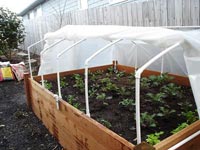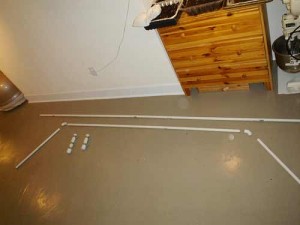See Related Instructions: How to Make A Cold Frame for a Raised Garden Bed
Last year toward the end of summer, we built two large raised beds in a side yard. We opted for raised beds since the soil in that area of the yard is a combo of heavy clay and in-fill, but has great year-round sun (plus, we are over 40 and don’t feel like kneeling on the ground). Last fall we got in a few cold weather crops—lettuce, mustard, cabbage and peas. By the end of December we were down to some over-wintering cabbage and haggard parsley—finally consumed in a stir fry 2 weeks ago. This year we are planning a much bigger garden. Even though we don’t quite trust the weather yet, we’ve already planted some starts. We also have seedlings galore sprouted in the basement that will soon require a new home. The answer—a cold frame over one of the raised beds. We plan to use the covered bed to both harden off the babies and get a jump on tomatoes which are always a challenge in rainy, grey weather. And, the biggest incentive—year-round salad greens!
Lisa, who loves to build things, was excited at a new project. Nicole, who eats more greens than seems possible for any living being, was thrilled at the prospect of pick-your-own in January. So, Lisa hit the internet, looking for ideas. A PVC structure seemed the way to go for several reasons:
- It’s easily customizable to height, length and width requirements.
- It can be disassembled and stowed in the summer—a consideration with limited storage.
- It’s cheap and easy to put together. The materials for this 8’X6’ frame cost just under $60. It can be assembled in under a day, maybe two if you decide to modify in any significant fashion. The only tools required are a jigsaw, staple gun, clamps, and screw driver.
A few considerations dictated this design for our location. We are at the top a large hill and get high winds frequently. The structure and tie-down system for the plastic sheeting had to be very sturdy. We wanted to leave the cover on until quite late, and still be able to let in rain on warm days and ventilate on hot ones. That requires the structure be firmly secured to the raised bed frame, yet designed so that the plastic can be rolled up at will. A friend noted that a simple hoop structure squashed large plants at the edge of the bed, so we also wanted a bit of vertical lift at the sides.
After reviewing plans and how-to videos on YouTube, this design came into being. One inch PVC holders anchor five 1/2” PVC ribs to the raised bed firmly, making removal a snap. A ridge pole tied to the ribs and then anchored to the ends of the bed with added pipe provides stability. Lisa chose to make the tie-down PVC clips (expensive versions spotted in a garden supply catalog) from 1” pipe –cheap, easy to get on and off and very secure. (If that seems like too much of a pain, large clips from the office supply store also work well.) The long sides of plastic sheeting are stapled to long boards and rest on the top edge of the bed. They can be used to fold the plastic up on warm day. Lisa created very secure “T” tie-down with some ½” pipe for the excess sheeting on the short ends of the bed, but if you don’t have high winds, clips alone would do the job.
Be sure to watch the slide show that provides step-by-step visual instructions.
Next week, TwoJunes entertain with a big Sunday dinner—slow food for a slow day. This relaxed meal with friends or family then provides meals during the crazy work week. We will be making posole, a long-simmered Mexican pork stew with all the fixings.

Lisa Bell is a freelance producer, writer and editor. She spent the first fifteen years of her working life as a pastry chef, recipe developer, test kitchen director, food stylist and print editor. She has also taught cooking classes, run a small cooking school, and worked as a food scientist. Nicole Rees currently works as a baking scientist. She is also a food writer and cookbook author specializing in baking science. Her most recent book Baking Unplugged, is filled with simple, scratch recipes that require no electric gadgets beyond an oven.


